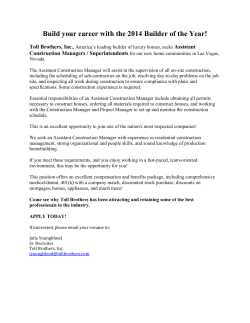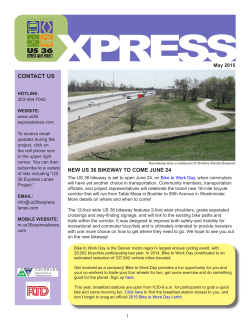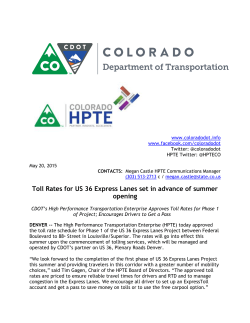
Can you afford to pay $8/day to drive into San Antonio?
Proposed Toll Road Can you afford to pay $8/day to drive into San Antonio? The published toll rate to use US 281 during peak hours is 50 cents per mile. If you use the toll lanes the full distance, that adds up to $8/day or over $2,000/yr. That’s just for one driver, one roundtrip per day. Consider all the other trips for those in your household and tolls could exceed $4,000/yr in new taxes on driving. But it won’t stop there. Tolls are planned on Loop 1604, I-10, and & I-35. There will be no way into San Antonio from the Hill Country without confronting tolls. Concerns with a Super Street in Comal County TxDOT added a super street concept to US 281 and a stretch of Loop 1604 in Bexar County to improve traffic flow where stop lights already existed, but now they want to impose a superstreet up into the Bulverde area through Comal County where there are NO stop lights. Though the initial plan is to construct elongated ‘J-turns’ that won’t have a traffic signal at first, it will eventually ADD stop lights to Hwy 281 where traffic flows unencumbered by stop lights today. A super street concept is better than adding traditional stop lights across the highway as occurred in Bexar County. But we want to be sure our officials get the message loud and clear, we DO NOT want to ADD unwarranted stop lights on US 281. Why? Stop lights have been exploited by TxDOT in the past as an excuse to toll the road when overpasses are eventually needed. Communicate that you DO NOT want an extension of the toll road into Comal County in a few years when the delays created by stop lights cause unbearable gridlock. Be sure you & your neighbors get your input ON THE RECORD opposing any immediate imposition of ANY stop lights on US 281 through Comal County. Submit comments to: ricardo.flores@txdot.gov by July 19. TO CONTACT ELECTED OFFICIALS: Sen. Donna Campbell - (830) 626-0065 or donna.campbell@senate.state.tx.us Rep. Doug Miller - (830) 625-1313 or doug.miller@house.state.tx.us For more info go to www.TexasTURF.org www.TollfreeHighways.com Proposed Toll Road Sign-up for email updates on 281 at www.TexasTURF.org Contact info: Terri Hall at 210-275-0640 or terri@texasturf.org The plan morphed from a completed, streamlined expressway design (upgrading the corridor adding two new lanes, needed overpasses, and access roads) to a hybrid toll-transit-HOV mix with fewer non-toll highway lanes than we have today — non-toll lanes that cease at Stone Oak Parkway. Flaws with US 281 Toll Plan (in addition to those on the front page) • Current Toll Plan does NOT add ANY new highway lanes from Loop 1604 to Stone Oak Pkwy. The current toll plan adds no new lanes south of Stone Oak Pkwy, therefore it does NOT meet the purpose and need of the project, which is to improve mobility and relieve congestion in the corridor. The non-toll highway lanes adjacent to the middle HOV/Transit toll lanes will remain congested without new added capacity. The section north of Stone Oak Pkwy. that turns into a toll-only highway (no free highway lanes) will not meet the purpose and need of the project since it will displace traffic avoiding the toll onto frontage roads and neighborhood streets creating permanent congestion in the corridor and an underutilized tollway (like SH 130). • What’s driving up the cost? First, there are 9 overpasses planned in just 7 miles. That’s OVERKILL, not every subdivision needs its own overpass. Each one costs about $10 million, so eliminating some of the overpasses would shave cost and help make a non-toll option more affordable. Second, the plan also includes an extravagant, exclusive Via transit lane and direct connect ramp ($56 million is the estimate available) to its planned Park-N-Ride facility at the corner of Stone Oak Pkwy. and Hwy 281. It’s estimated to be up to 75 feet in the air (as tall as the southern direct connect interchange ramps at 1604). The Via exclusive transit lane and ramp can only be accessed in two places – just north of Evans Road near the HEB and just north of Stone Oak Pkwy. The lanes dump into the toll lanes in the center of 281 so the transit riders needing to travel to Loop 1604 can’t take the transit lanes. It’s designed for travelers who are headed south of Loop 1604 on Hwy 281 with very limited stops until downtown. Anyone who has to travel to Loop 1604 cannot exit the Park-N-Ride using the ramp, those travelers are dumped onto Stone Oak Pkwy. Any buses needing to get to 1604 will be forced to take Stone Oak Pkwy. Since the transit lane doesn’t even connect to 1604, it doesn’t connect to all the major destinations and job centers along 1604 and I-10 (like USAA, UTSA, & the Medical Center), so it limits riders exclusively to north-south travel only. Much of the 281 traffic heading south peels off at 1604 & is not headed all the way downtown. Third, the project includes bike & pedestrian pathways throughout the entire 7 mile corridor adding unnecessary cost. Bikes & pedestrians can safely travel along the planned frontage roads. Fourth, the project also includes ‘context sensitive solutions’ like artistic elements , accent lighting, rain gardens, etc. All of these extra costs need to be eliminated. • The money is there to fix 281 WITHOUT tolls The excuse to toll 281 is there’s not enough money. But the expansion and overpasses were fully funded through 2008 when that tax money disappeared. Still today, the financing for the project is NOT backed by tolls. $228 million is non-toll tax money ($60 million is for the interchange ramps). The remaining $230 million will be a loan from TxDOT or the federal government. Local politicians just doubled Bexar County registration fees. They’re already using half of it, $70 million, to build NON-toll lanes on 1604 (at a cost of roughly $20 million/mile yet 281 supposedly costs $48 million/ mile - something’s wrong with this picture). Taking the 1604 example, to fix 7.8 miles on 281 at $20 million/mile would cost $156 million–add in the $85 million still needed for right of way & that’s $241 million, yet the RMA claims it’s $458 million. Why not spend the other $70 million in registration fees toward completing 281 without tolls? Why not nix the exclusive Via ramp to shave cost (est. $56 million) or nix some of the extraneous overpasses or bike paths? The answer is politics. Our representatives in the 281 corridor have let over $1 billion in non-toll road taxes slip by and spent it on everything BUT 281. • Taxpayers on the hook for the losses The toll road isn’t remotely financially viable (can’t pay for itself with just the toll payers), so the RMA will use the taxpayers as their bailout plan and loan guarantor by using a State Infrastructure Bank loan from TxDOT or a taxpayer-backed federal TIFIA loan rather than bonds backed exclusively by tolls (that taxpayers aren’t responsible for repaying). • Cash toll payers will be charged more & the HOV ‘catch’ Since the tolling will be all electronic, you have to be registered with the government & give them access to your bank account. A TollTag is required to get a lower toll rate (toll rate range: 17-50 cents a mile). Those who get billed by mail will pay 33-50% higher toll rates. HOV must be pre-registered with the government & have an active TollTag (that costs money to keep open). It requires 3 or more people to be in your car. So just hopping into the HOV/toll lane to go to lunch with colleagues won’t count as a qualified HOV ‘free ride.’ Moms in minivans shuttling kids to soccer practice also won’t qualify either unless you register in advance and meet the qualifications as a ‘registered, declared’ carpool vehicle. • No meaningful study of economic impacts to residents, businesses, employees in the corridor as required by federal law (NEPA) The Draft EIS acknowledges (Vol I, Chap. 3 p. 215) traffic trying to avoid paying tolls will be displaced onto neighborhood streets. This effects safety, schools, property values, quality of life, and access to gainful employment. The tolled options DO NOT meet the purpose and need of the project when it will merely displace congestion into neighborhoods, rather than relieve it. Driving congested, stop-light ridden frontage roads is NOT an efficient nor effective alternative to freeway lanes. The EIS claims if someone can’t afford tolls, they can use the frontage roads. Making those who can’t afford tolls second class citizens relegated to congested free routes is not only patently unfair (especially since they’re paying gas tax for state highways), it’s discriminatory and inefficient.
© Copyright 2025















